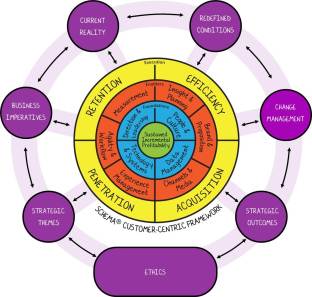Designing and executing a customer-centric business model requires end to end organisational alignment. Customer-centric capability development cannot take place in isolation to the rest of the business. The customer-centric journey requires a clear quantified understanding of current organisational capability across all 14 capability areas of the SCHEMA® Customer Management framework in the centre of the REAP Customer-Centric Blueprint below. As important as an understanding of current customer management capability is, so too is an understanding of the capability to which the organisation aspires.
Each week I’ll address another single capability area, sharing with you the Transformation Intent to which your organisation should commit to, as well as ‘What Good Looks Like’ for those organisations that have achieved a fairly high level of maturity in the respective capability area.
The REAP Customer-Centric Organisation Blueprint®
This week we are dealing with People & Culture which is one of the four Foundational capability areas represented. The Foundations layer includes the fundamental building blocks that support or limit your transformation ability. These capability areas require broad-based input and alignment, without which the operationalization of a customer-centric business model is almost impossible.
Transformation Intent – People & Culture
“While conventional wisdom dictates that customer-centricity means customers should always be put first, in reality, it requires that employees are first and foremost given what they need so that they can deliver sustainable and superior customer experiences. To do that you need to transform your organisation’s culture into one of customer-centricity, and then empower your team to deliver excellence in alignment with that culture. Customer-centricity also requires that you engage with your suppliers and channel partners as if they were part of your core team.”
What Good Looks Like – People & Culture
- The organisations desired ‘Customer Culture’ is realistically achievable and clearly described / illustrated to staff so they know what is expected of them even before they are appointed. Employee engagement is planned into all Customer Management activity/ change and is achieved using the formal channels to employees effectively and by using informal channels in support.
- The requirements of the Customer Management function and the impact of changes on Customers are fully considered in making organisational changes and any barriers are being dealt with.
- The customer-impacting competences required and those that are actually available are understood and mechanisms in place to close the gap.
- External suppliers are used where it is strategically sensible to do so and selected / monitored against the quality of customer experience they will deliver as well as internal / cost considerations. The term ‘Partner’ is used where there is a real level of partnership and describes third-parties that are a close match to the organisation and integrated so that the partner’s staff feels part of a partnership.
For more insight into customer-centric business model innovation as well as more insight into this particular area of the REAP Customer-Centric Blueprint, please see my book “The Customer-Centric Blueprint’ – http://amzn.to/ZILg4y




